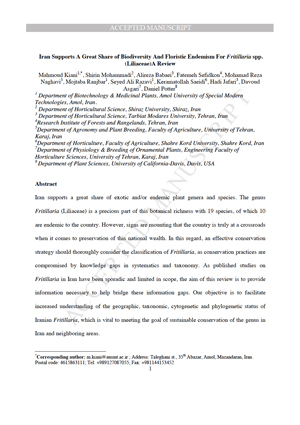NEWS 2017
Iran Supports A Great Share of Biodiversity And Floristic Endemism For Fritillaria spp. (Liliaceae) A Review
Mahmoud KIANI¹, Shirin MOHAMMADI², Alireza BABAEI³, Fatemeh SEFIDKON⁴, Mohamad Reza NAGHAVI⁵, Mojtaba RANJBAR¹, Seyed Ali RAZAVI¹, Keramatollah SAEIDI⁶, Hadi JAFARI³, Davoud ASGARI7, Daniel POTTER8
Plant Diversity – Accepted Manuscript
http://dx.doi.org/10.1016/j.pld.2017.09.002
1Department of Biotechnology & Medicinal Plants, Amol University of Special Modern Technologies, Amol, Iran
2Department of Horticultural Science, Shiraz University, Shiraz, Iran
3Department of Horticultural Science, Tarbiat Modares University, Tehran, Iran
4Research Institute of Forests and Rangelands, Tehran, Iran
5Department of Agronomy and Plant Breeding, Faculty of Agriculture, University of Tehran, Karaj, Iran
6Department of Horticulture, Faculty of Agriculture, Shahre Kord University, Shahre Kord, Iran
7Department of Physiology & Breeding of Ornamental Plants, Engineering Faculty of Horticulture Sciences, University of Tehran, Karaj, Iran
8Department of Plant Sciences, University of California-Davis, Davis, USA
Abstract
Iran supports a great share of exotic and/or endemic plant genera and species. The genus Fritillaria (Liliaceae) is a precious part of this botanical richness with 19 species, of which 10 are endemic to the country. However, signs are mounting that the country is truly at a crossroads when it comes to preservation of this national wealth. In this regard, an effective conservation strategy should thoroughly consider the classification of Fritillaria, as conservation practices are compromised by knowledge gaps in systematics and taxonomy. As published studies on Fritillaria in Iran have been sporadic and limited in scope, the aim of this review is to provide information necessary to help bridge these information gaps. Our objective is to facilitate increased understanding of the geographic, taxonomic, cytogenetic and phylogenetic status of Iranian Fritillaria, which is vital to meeting the goal of sustainable conservation of the genus in Iran and neighbouring areas.




